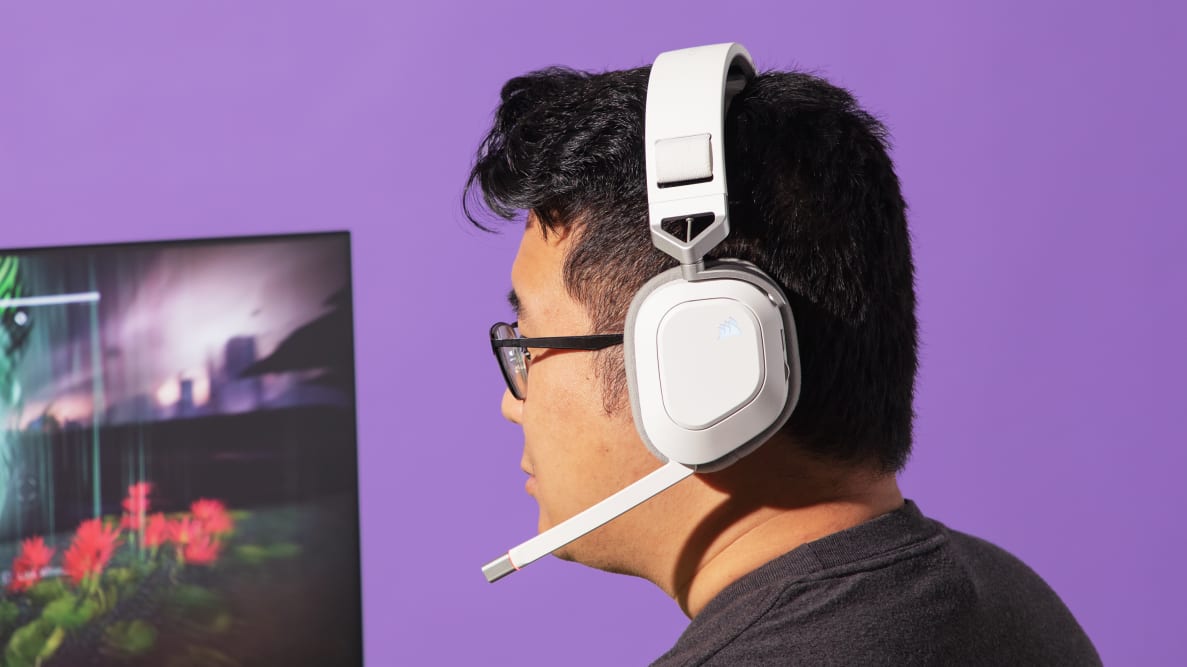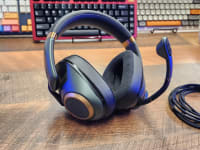Pros
-
Loud and balanced audio
-
Long runtime
-
Multiple connections
Cons
-
Heavy and uncomfortable
-
Unimpressive mic
-
Dolby Atmos doesn't add much
The Corsair HS80 Max Wireless pumps out powerful audio that’s largely a joy to the ears, but any headset you can get for $180 ought to hit that mark. Unfortunately, all of the included extras, like Dolby Atmos support, don’t necessarily propel it forward. It’s a fine headset, if a bit uncomfortable for the long-term, but you can certainly get better for the money.
About the Corsair HS80 Max Wireless
Here are the specs of the headset we tested:
- Cost: $180
- Style: Over-ear, closed-back
- Colors: Steel Gray, White
- Drivers: Custom 50mm neodymium drivers
- Wireless connections: 2.4Ghz Slipstream Wireless via USB-A (included dongle), Bluetooth 5.2
- Battery life: 65 hours (RGB off), 24 hours (RGB on), 130 hours (Bluetooth, RGB off)
- Device compatibility: PC, Mac, PlayStation 5, PlayStation 4
- Microphone: Flip-to-mute, omnidirectional
- Virtual surround sound: Dolby Atmos (via Corsair iCue on PC), Tempest 3D (PS5)
- Weight: 354g
The Corsair HS80 Max Wireless is the top-line model in the HS80 family. There is an HS80 RGB Wireless headset that eschews the Bluetooth connectivity and lowers the battery life for $150. There is also a wired HS80 headset for $100 (though it frequently goes on sale).
What we like
Deep, full sound that rips
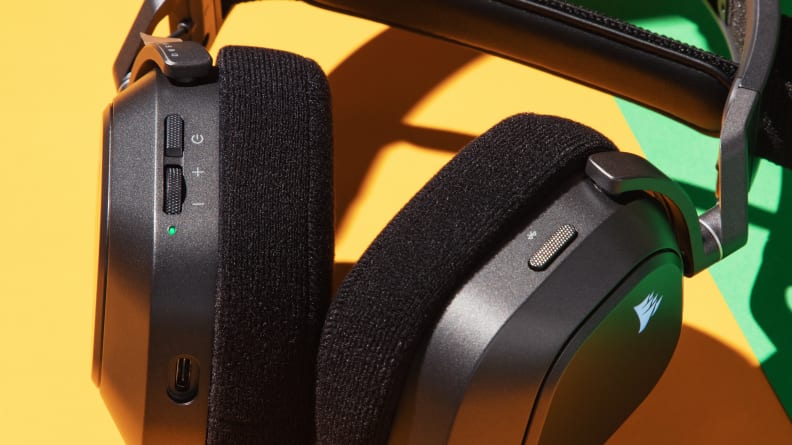
The ear cups don't offer much in the way of sound isolation, but the headphones can put out plenty of noise.
Bass is at the forefront for the Corsair HS80 Max. From the thumping bass of Of Montreal’s “I Feel Ya Strutter” to the booming explosions of an enemy vehicle in Battlefield 2042 succumbing to that last hit from a missile, these cans can roar. When an enemy attack chopper hounded me in one match, the constant barrage of missiles and the swooping of it overhead were as dramatic as can be. Best of all, that hefty bass doesn’t come at the cost of respectable mids and treble.
When I say these headphones boom, I mean it. They can get obscenely loud. So loud that I rarely turn the volume up past 20%. If you like listening to music as bumping as possible, this headset can do it, but you’ll want to take care you don’t harm your hearing.
Plenty of ways to customize sound
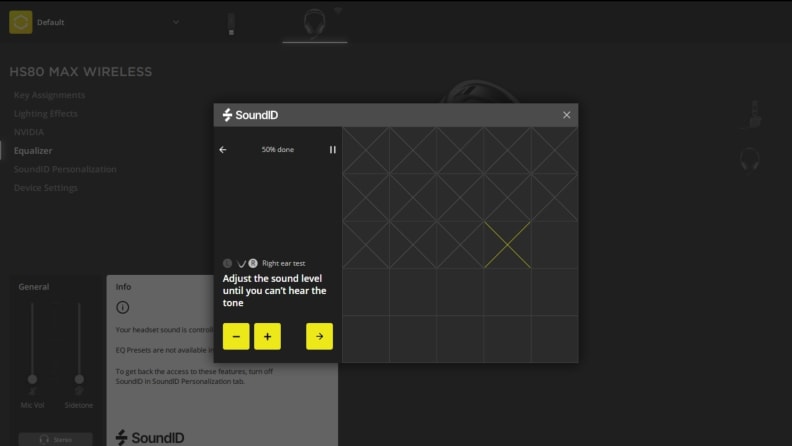
The iCue app works great as a personal sound mixer for the headphones.
While the audio from the HS80 Max Wireless is good out of the box, there are a lot of tools to tailor it to your liking. Corsair’s iCue app may not be my favorite, but it includes a 10-band equalizer so you can tune in the sound you want or choose from a handful of presets. If you don’t want to use these EQ settings, it also offers SoundID, which can walk you through a hearing test and then help you select a sound profile that you like most. These settings are available on both PC and Mac versions of iCue.
To top it off, the headset includes a linked Dolby Atmos license. This lets you tap into the virtualized surround feature using the Dolby Access app for Windows. From there, you can further customize your audio with various EQ presets of its own, or the option to create yet another 10-band EQ profile for yourself. Unfortunately, it’s not a one-click setup (more on that later).
Respectable battery life
The Corsair HS80 Max Wireless advertises a 24-hour battery life, and I’ve hammered these cans with plenty of use over a couple of weeks and only charged them once. That runtime holds up, and is the lower-end runtime you’ll get with RGB lighting enabled. It’s just a little glowing Corsair logo on the earcups that’s not much to get excited about, and nothing you can actually see while wearing them.
Turning the RGB lighting off can bump the runtime up to 65 hours. Now we’re talking about the big leagues for wireless headset battery life. Over Bluetooth, Corsair claims the HS80 Max Wireless can run for 130 hours. While you’ll be best off using the USB wireless transmitter for low-latency, high-bandwidth audio while gaming, the option to switch to Bluetooth when you want to save battery is a nice extra and provides more flexibility for the devices you can connect to.
What we don’t like
Comfort isn’t all that great
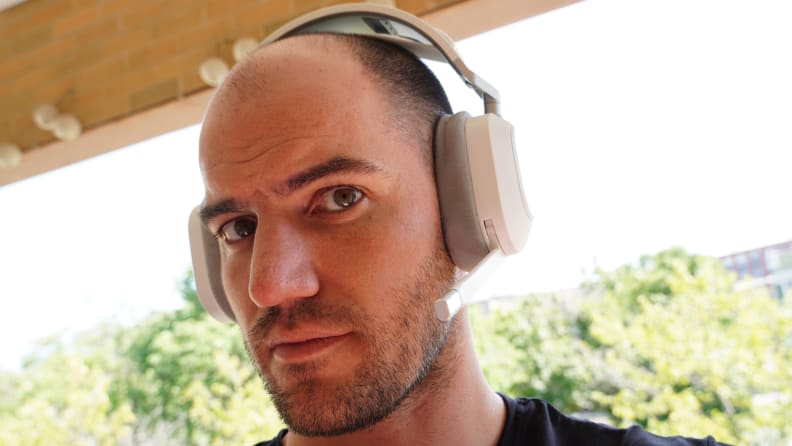
Despite the robust headband, our reviewer still felt the weight after long gaming sessions.
The fabric finish of the ear cushions on the Corsair HS80 Max Wireless doesn’t win it any points. For one, they don’t offer a lot of noise isolation. This is a common downside to fabric ear cushions as opposed to leather or leatherette, which can seal out more sound.
Sitting in a cafe with music playing overhead, I had to turn the Corsair headset up to an almost painful level to drown it out. Even then much of the bass passed through the headset to throw off the rhythm of what I was listening to.
It would be one thing if the noise leak came with an improvement to comfort or breathability like the cushions on most SteelSeries headsets do. But the fabric finish of the ear cushions is a bit warmer, making it uncomfortable for long gaming sessions. The weave of the material also has shown a knack for grabbing onto my facial hair. It won’t be a problem for everyone, but it’ll be a problem for plenty.
Then there’s the weight. At 354 grams, it’s 10% heavier than the monstrously large Sony Inzone H9. It’s not as bulky, but it’s still a lot of weight to have on your head for hours at a time. The HS80 Max Wireless has a firm clamping force, but even with its suspension band, I still get a hot spot of discomfort on the crown of my head after a little over an hour of wear.
Setting up Dolby Atmos is a pain
I’m able to get a pretty good sense of my surroundings with these headphones on, but that’s not a terribly unique feature for a decent set of cans. That spatial awareness applies whether I’ve gone through all the hoops to enable Dolby Atmos, which requires an extra app beyond iCue, or not.
Enabling Dolby Atmos for content that doesn’t support it has little clear benefit, and can actually detract from it. When Dolby Atmos is applied, it remixes the audio (whether it’s meant to or not), sometimes lowering elements of the mix that stand out louder in normal stereo. If you like hearing people talk, it at least has a knack for keeping voices loud and center.
I played hours of Battlefield 2042 with the feature enabled and caught more than a few enemies sneaking up on my flank, but I had just as easy a time picking them out with Dolby Atmos disabled. The feature also only works on PC, which is a limitation for a headset made to support so many different devices.
Ultimately, this isn’t a major issue. It’s better to have Dolby Atmos as an option than not. But the Dolby Atmos license is undoubtedly factored into the price of this headset, and it doesn’t offer a lot.
Headsets this flexible shouldn’t communicate with beeps
I tried connecting the Corsair HS80 Max to my PS5 one day while testing, and I couldn’t get the connection to take. I figured maybe it was an issue with the console. The next day, the headset wouldn’t connect with my PC. The dongle flashed red and the headset mic was flashing blue and red. Reading the instructions, I understood the flashing dongle to mean the headset and dongle weren’t connecting. Switching to Bluetooth didn’t get the headset to show up for my PC, either. At least that’s what I thought, because the dedicated Bluetooth button is somehow not actually responsible for switching modes.
I was prepared to dig into iCue and re-pair the dongle and headset all over again. As it turned out, the headset was in Bluetooth mode the whole time. The Corsair HS80 Max just beeps a few times, which wasn’t enough for me to understand the headset was simply not in RF Wireless mode the whole time I struggled to get it connected.
The mic sometimes misbehaves
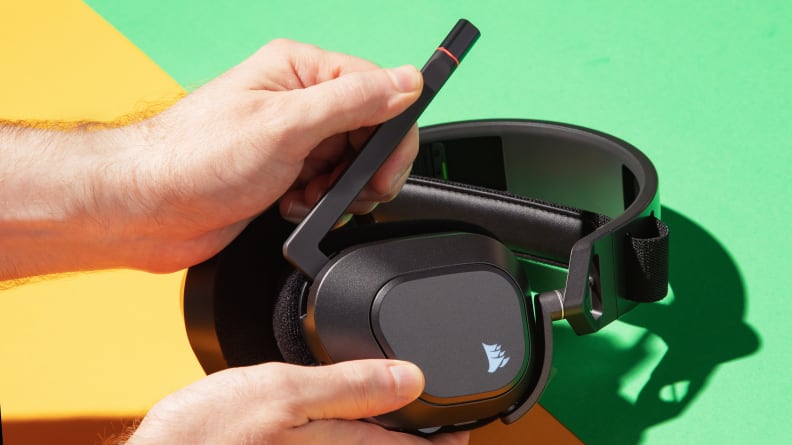
The mic quality is nothing special, and it often fails to mute when flipped up.
This may be small potatoes, but I’ve noticed the microphone on the headset occasionally kicks in even when it’s flipped up to mute—not all the time, but pretty much every day.
It doesn’t appear to actually record and send audio to the attached computer, but side-tone suddenly comes on and sends subtle white noise into the cans even while the red mute indicator light is lit. This should not only not happen, but it should not be able to happen for a hardware cutoff.
Top that off with middling, compressed audio quality from the mic, and the fact that it’s flip-to-mute and not a retractable or detachable mic for when you’re out and about, and you’ve got the recipe for a fairly disappointing mic.
Should you buy the Corsair HS80 Max Wireless?
No, they’re just a hard sell
The Corsair HS80 Max Wireless could be worthwhile for a select few. If you don’t mind the weight, find it on sale, and know for a fact you want that Dolby Atmos license ($15 on its own), then it might make sense. But unless those stars align, there are better options on the list of best gaming headsets that make more sense.
You can get plenty good audio from SteelSeries’ Arctis Nova 7 while also enjoying a more comfortable headset, lengthy battery life, and similar wireless connectivity.
If you don’t need Bluetooth connectivity, you can get a comfortable wireless headset from HyperX for $170 with extra long battery life. The new HyperX Cloud III Wireless boasts a runtime over 100 hours, and the earlier HyperX Cloud Alpha Wireless went for 300 hours. Both headsets are cheaper than Corsair’s as well, so you can snag that Dolby Atmos license with the money you save if you really want it.
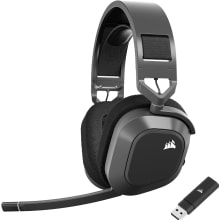
Customizable sound with a long-lasting battery, this headset brings some personalization and loud noise to the table.
Buy at AmazonMeet the tester

Mark Knapp
Contributor
Mark Knapp has covered tech for most of the past decade, keeping readers up to speed on the latest developments and going hands-on with everything from phones and computers to e-bikes and drones to separate the marketing from the reality. Catch him on Twitter at @Techn0Mark or on Reviewed, IGN, TechRadar, T3, PCMag, and Business Insider.
Checking our work.
Our team is here for one purpose: to help you buy the best stuff and love what you own. Our writers, editors, and lab technicians obsess over the products we cover to make sure you're confident and satisfied. Have a different opinion about something we recommend? Email us and we'll compare notes.
Shoot us an email